Zining Wang
SentiMM: A Multimodal Multi-Agent Framework for Sentiment Analysis in Social Media
Aug 25, 2025Abstract:With the increasing prevalence of multimodal content on social media, sentiment analysis faces significant challenges in effectively processing heterogeneous data and recognizing multi-label emotions. Existing methods often lack effective cross-modal fusion and external knowledge integration. We propose SentiMM, a novel multi-agent framework designed to systematically address these challenges. SentiMM processes text and visual inputs through specialized agents, fuses multimodal features, enriches context via knowledge retrieval, and aggregates results for final sentiment classification. We also introduce SentiMMD, a large-scale multimodal dataset with seven fine-grained sentiment categories. Extensive experiments demonstrate that SentiMM achieves superior performance compared to state-of-the-art baselines, validating the effectiveness of our structured approach.
WikiGap: Promoting Epistemic Equity by Surfacing Knowledge Gaps Between English Wikipedia and other Language Editions
May 30, 2025Abstract:With more than 11 times as many pageviews as the next, English Wikipedia dominates global knowledge access relative to other language editions. Readers are prone to assuming English Wikipedia as a superset of all language editions, leading many to prefer it even when their primary language is not English. Other language editions, however, comprise complementary facts rooted in their respective cultures and media environments, which are marginalized in English Wikipedia. While Wikipedia's user interface enables switching between language editions through its Interlanguage Link (ILL) system, it does not reveal to readers that other language editions contain valuable, complementary information. We present WikiGap, a system that surfaces complementary facts sourced from other Wikipedias within the English Wikipedia interface. Specifically, by combining a recent multilingual information-gap discovery method with a user-centered design, WikiGap enables access to complementary information from French, Russian, and Chinese Wikipedia. In a mixed-methods study (n=21), WikiGap significantly improved fact-finding accuracy, reduced task time, and received a 32-point higher usability score relative to Wikipedia's current ILL-based navigation system. Participants reported increased awareness of the availability of complementary information in non-English editions and reconsidered the completeness of English Wikipedia. WikiGap thus paves the way for improved epistemic equity across language editions.
Fine-Grained Evaluation of Large Vision-Language Models in Autonomous Driving
Mar 27, 2025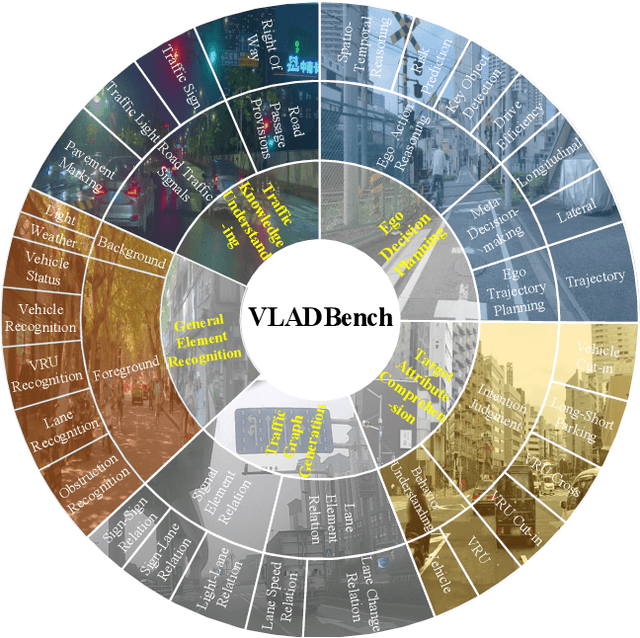

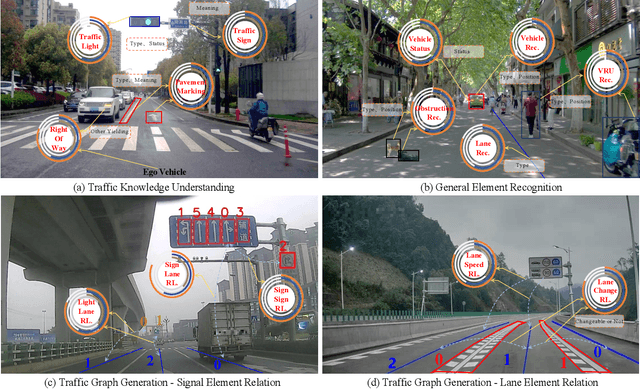

Abstract:Existing benchmarks for Vision-Language Model (VLM) on autonomous driving (AD) primarily assess interpretability through open-form visual question answering (QA) within coarse-grained tasks, which remain insufficient to assess capabilities in complex driving scenarios. To this end, we introduce $\textbf{VLADBench}$, a challenging and fine-grained dataset featuring close-form QAs that progress from static foundational knowledge and elements to advanced reasoning for dynamic on-road situations. The elaborate $\textbf{VLADBench}$ spans 5 key domains: Traffic Knowledge Understanding, General Element Recognition, Traffic Graph Generation, Target Attribute Comprehension, and Ego Decision-Making and Planning. These domains are further broken down into 11 secondary aspects and 29 tertiary tasks for a granular evaluation. A thorough assessment of general and domain-specific (DS) VLMs on this benchmark reveals both their strengths and critical limitations in AD contexts. To further exploit the cognitive and reasoning interactions among the 5 domains for AD understanding, we start from a small-scale VLM and train the DS models on individual domain datasets (collected from 1.4M DS QAs across public sources). The experimental results demonstrate that the proposed benchmark provides a crucial step toward a more comprehensive assessment of VLMs in AD, paving the way for the development of more cognitively sophisticated and reasoning-capable AD systems.
Marten: Visual Question Answering with Mask Generation for Multi-modal Document Understanding
Mar 18, 2025Abstract:Multi-modal Large Language Models (MLLMs) have introduced a novel dimension to document understanding, i.e., they endow large language models with visual comprehension capabilities; however, how to design a suitable image-text pre-training task for bridging the visual and language modality in document-level MLLMs remains underexplored. In this study, we introduce a novel visual-language alignment method that casts the key issue as a Visual Question Answering with Mask generation (VQAMask) task, optimizing two tasks simultaneously: VQA-based text parsing and mask generation. The former allows the model to implicitly align images and text at the semantic level. The latter introduces an additional mask generator (discarded during inference) to explicitly ensure alignment between visual texts within images and their corresponding image regions at a spatially-aware level. Together, they can prevent model hallucinations when parsing visual text and effectively promote spatially-aware feature representation learning. To support the proposed VQAMask task, we construct a comprehensive image-mask generation pipeline and provide a large-scale dataset with 6M data (MTMask6M). Subsequently, we demonstrate that introducing the proposed mask generation task yields competitive document-level understanding performance. Leveraging the proposed VQAMask, we introduce Marten, a training-efficient MLLM tailored for document-level understanding. Extensive experiments show that our Marten consistently achieves significant improvements among 8B-MLLMs in document-centric tasks. Code and datasets are available at https://github.com/PriNing/Marten.
A Token-level Text Image Foundation Model for Document Understanding
Mar 04, 2025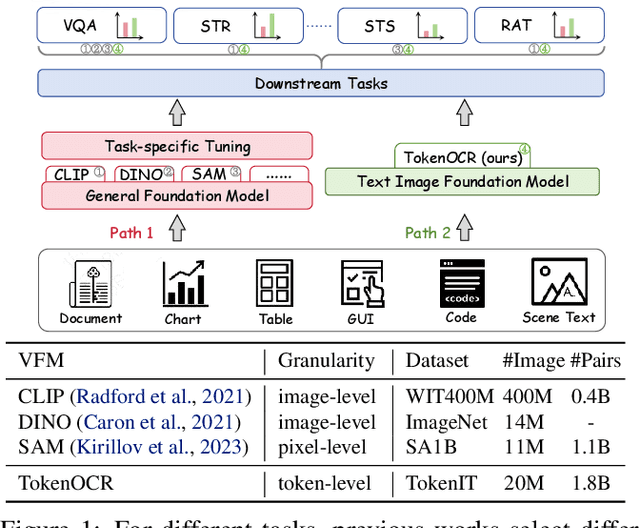
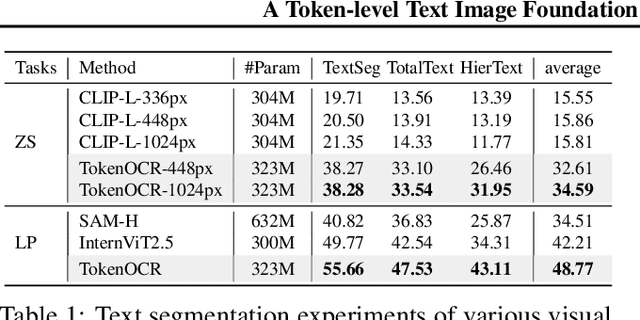
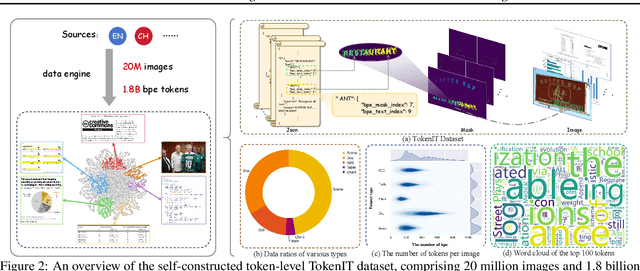

Abstract:In recent years, general visual foundation models (VFMs) have witnessed increasing adoption, particularly as image encoders for popular multi-modal large language models (MLLMs). However, without semantically fine-grained supervision, these models still encounter fundamental prediction errors in the context of downstream text-image-related tasks, i.e., perception, understanding and reasoning with images containing small and dense texts. To bridge this gap, we develop TokenOCR, the first token-level visual foundation model specifically tailored for text-image-related tasks, designed to support a variety of traditional downstream applications. To facilitate the pretraining of TokenOCR, we also devise a high-quality data production pipeline that constructs the first token-level image text dataset, TokenIT, comprising 20 million images and 1.8 billion token-mask pairs. Furthermore, leveraging this foundation with exceptional image-as-text capability, we seamlessly replace previous VFMs with TokenOCR to construct a document-level MLLM, TokenVL, for VQA-based document understanding tasks. Finally, extensive experiments demonstrate the effectiveness of TokenOCR and TokenVL. Code, datasets, and weights will be available at https://token-family.github.io/TokenOCR_project.
Multimodal Large Language Models for Text-rich Image Understanding: A Comprehensive Review
Feb 23, 2025Abstract:The recent emergence of Multi-modal Large Language Models (MLLMs) has introduced a new dimension to the Text-rich Image Understanding (TIU) field, with models demonstrating impressive and inspiring performance. However, their rapid evolution and widespread adoption have made it increasingly challenging to keep up with the latest advancements. To address this, we present a systematic and comprehensive survey to facilitate further research on TIU MLLMs. Initially, we outline the timeline, architecture, and pipeline of nearly all TIU MLLMs. Then, we review the performance of selected models on mainstream benchmarks. Finally, we explore promising directions, challenges, and limitations within the field.
InstructOCR: Instruction Boosting Scene Text Spotting
Dec 20, 2024Abstract:In the field of scene text spotting, previous OCR methods primarily relied on image encoders and pre-trained text information, but they often overlooked the advantages of incorporating human language instructions. To address this gap, we propose InstructOCR, an innovative instruction-based scene text spotting model that leverages human language instructions to enhance the understanding of text within images. Our framework employs both text and image encoders during training and inference, along with instructions meticulously designed based on text attributes. This approach enables the model to interpret text more accurately and flexibly. Extensive experiments demonstrate the effectiveness of our model and we achieve state-of-the-art results on widely used benchmarks. Furthermore, the proposed framework can be seamlessly applied to scene text VQA tasks. By leveraging instruction strategies during pre-training, the performance on downstream VQA tasks can be significantly improved, with a 2.6% increase on the TextVQA dataset and a 2.1% increase on the ST-VQA dataset. These experimental results provide insights into the benefits of incorporating human language instructions for OCR-related tasks.
HarmoniCa: Harmonizing Training and Inference for Better Feature Cache in Diffusion Transformer Acceleration
Oct 02, 2024Abstract:Diffusion Transformers (DiTs) have gained prominence for outstanding scalability and extraordinary performance in generative tasks. However, their considerable inference costs impede practical deployment. The feature cache mechanism, which involves storing and retrieving redundant computations across timesteps, holds promise for reducing per-step inference time in diffusion models. Most existing caching methods for DiT are manually designed. Although the learning-based approach attempts to optimize strategies adaptively, it suffers from discrepancies between training and inference, which hampers both the performance and acceleration ratio. Upon detailed analysis, we pinpoint that these discrepancies primarily stem from two aspects: (1) Prior Timestep Disregard, where training ignores the effect of cache usage at earlier timesteps, and (2) Objective Mismatch, where the training target (align predicted noise in each timestep) deviates from the goal of inference (generate the high-quality image). To alleviate these discrepancies, we propose HarmoniCa, a novel method that Harmonizes training and inference with a novel learning-based Caching framework built upon Step-Wise Denoising Training (SDT) and Image Error Proxy-Guided Objective (IEPO). Compared to the traditional training paradigm, the newly proposed SDT maintains the continuity of the denoising process, enabling the model to leverage information from prior timesteps during training, similar to the way it operates during inference. Furthermore, we design IEPO, which integrates an efficient proxy mechanism to approximate the final image error caused by reusing the cached feature. Therefore, IEPO helps balance final image quality and cache utilization, resolving the issue of training that only considers the impact of cache usage on the predicted output at each timestep.
A Survey of Low-bit Large Language Models: Basics, Systems, and Algorithms
Sep 25, 2024



Abstract:Large language models (LLMs) have achieved remarkable advancements in natural language processing, showcasing exceptional performance across various tasks. However, the expensive memory and computational requirements present significant challenges for their practical deployment. Low-bit quantization has emerged as a critical approach to mitigate these challenges by reducing the bit-width of model parameters, activations, and gradients, thus decreasing memory usage and computational demands. This paper presents a comprehensive survey of low-bit quantization methods tailored for LLMs, covering the fundamental principles, system implementations, and algorithmic strategies. An overview of basic concepts and new data formats specific to low-bit LLMs is first introduced, followed by a review of frameworks and systems that facilitate low-bit LLMs across various hardware platforms. Then, we categorize and analyze techniques and toolkits for efficient low-bit training and inference of LLMs. Finally, we conclude with a discussion of future trends and potential advancements of low-bit LLMs. Our systematic overview from basic, system, and algorithm perspectives can offer valuable insights and guidelines for future works to enhance the efficiency and applicability of LLMs through low-bit quantization.
Fast and Controllable Post-training Sparsity: Learning Optimal Sparsity Allocation with Global Constraint in Minutes
May 09, 2024Abstract:Neural network sparsity has attracted many research interests due to its similarity to biological schemes and high energy efficiency. However, existing methods depend on long-time training or fine-tuning, which prevents large-scale applications. Recently, some works focusing on post-training sparsity (PTS) have emerged. They get rid of the high training cost but usually suffer from distinct accuracy degradation due to neglect of the reasonable sparsity rate at each layer. Previous methods for finding sparsity rates mainly focus on the training-aware scenario, which usually fails to converge stably under the PTS setting with limited data and much less training cost. In this paper, we propose a fast and controllable post-training sparsity (FCPTS) framework. By incorporating a differentiable bridge function and a controllable optimization objective, our method allows for rapid and accurate sparsity allocation learning in minutes, with the added assurance of convergence to a predetermined global sparsity rate. Equipped with these techniques, we can surpass the state-of-the-art methods by a large margin, e.g., over 30\% improvement for ResNet-50 on ImageNet under the sparsity rate of 80\%. Our plug-and-play code and supplementary materials are open-sourced at https://github.com/ModelTC/FCPTS.
 Add to Chrome
Add to Chrome Add to Firefox
Add to Firefox Add to Edge
Add to Edge